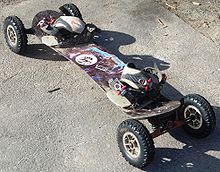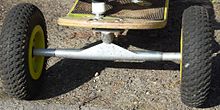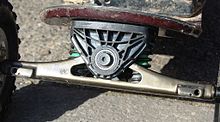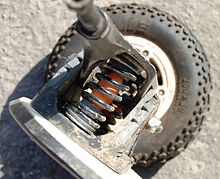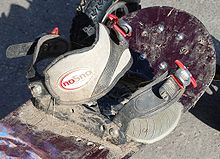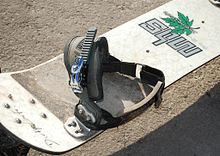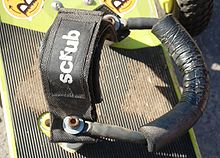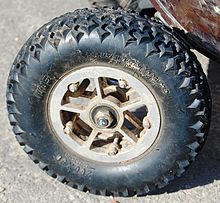- Mountainboarding
-
Mountainboarding, also known as Dirtboarding, Offroad Boarding, Grass Boarding, and All-Terrain Boarding (ATB), is a well established[1] if little-known extreme sport, derived from snowboarding. A mountainboard is made up of components including a deck, bindings to secure the rider to the deck, four wheels with pneumatic tires, and two steering mechanisms known as trucks. Mountainboarders, also known as riders, ride specifically designed boardercross tracks, slopestyle parks, grass hills, woodlands, gravel tracks, streets, skateparks, ski resorts, BMX courses and mountain bike trails. It is this ability to ride such a variety of terrain that makes mountainboarding different from other board sports.
Contents
History
Origins
Morton Hellig's 'Supercruiser Inc.' was the first company to manufacture and retail the 'All Terrain Dirtboard', patented in 1989.[citation needed] Mountainboarding (name coined by Jason Lee) began in the UK, the USA and Australia in 1992. Unknown to each other, riders from other boardsports started to design and build, and eventually manufacture boards that could be ridden off-road. This desire to expand the possible terrain that a boarder can ride created the sport of Mountainboarding.[2]
UK
Dave and Pete Tatham, Joe Inglis and Jim Aveline, whilst looking for an off-season alternative to surfing and snowboarding, began designing boards that could be ridden down hills. Inglis developed initial prototypes, and in 1992 noSno was started. Extensive research and development produced the noSno truck system which enabled the boards to be steered and remain stable at high speeds.[citation needed] NoSno boards utilised snowboard bindings and boots, with large tyres for rough ground, and the option for a hand-operated hydraulic disc brake.[3][non-primary source needed]
USA
In 1992, after having snowboarded at Heavenly Valley Resort in Northern California, friends Jason Lee, Patrick McConnell and Joel Lee went looking for an alternative for the summer season. Not finding anything suitable they co-founded MountainBoardSports (MBS) in 1993 to build boards that they could use to carve down hills. The original MBS boards, known as 'Frame Boards' had a small wooden deck with metal posts to hold the rider's feet, a tubular metal frame connecting trucks which used springs to enable steering and thus create the carving sensation that the MBS co-founders were looking for.[4][non-primary source needed] The first recorded mountainboarding act occurred in the summer of 1978, when local skateboarder Mike Motta residing in Medford Massachusetts navigated down a hill known as Seven Bumps in Malden Massachusetts on a bet, using a standard Franklin skateboard.
Australia
John Milne developed a three-wheeled version of a mountainboard in 1992 in his spare time during periods of very poor surf. It used a unique steering system to emulate surfing on land. It had 3 wheels and a skate-style deck with no bindings.[5]
Mid-to-late nineties
From the early days of invention there has always been a competitive element in mountainboarding. Encompassing racing, freestyle and downhill, competitions have been organised in the USA since 1993 and in the UK since 1997. In the same year the ATBA-UK (All Terrain Boarding Association), the national governing body for mountainboarding in the UK was born.[6] As a non-profit making organisation it represented and promoted the sport by putting riders interests first, promoting safety, sanctioning events, providing training, and sourcing funding to put on the ATBA-UK National Series, an annual series of competitions. The competitions did much to promote the sport and in 1998 mountainboarding had an estimated participation of over 1 million athletes worldwide.[1] The components evolved, and the sport continued to grow. MBS developed the open heel binding, the channel truck, the "eggshock" and the reverse V Brake system and sold boards in around 30 countries worldwide. In 1998 Maxtrack started distributing MBS mountainboards in the UK and Europe.
Equipment
Board Components
Deck
Mountainboard decks are the part that most of the components are attached to, and provide the base for the rider to stand on. They are generally from 90–110 cm in length, and can be made from a range of construction methods and materials. For example high specification boards may be made from composite carbon and glass reinforced plastics, possibly with a wooden core, similarly made to a snowboard deck. Basic decks are generally made using laminated wood pressed into shape, comparable to a longboard deck with larger dimensions and a different shape. There are variable characteristics such as flex, weight, shape, length and tip angle that can be catered for in custom or stock boards from a variety of manufacturers.
Trucks
Trucks are the components made up of a hanger, damping and/or spring system, and axles which attach the wheels to the deck. They also have the mechanisms required to allow the board to turn.
Skate Trucks
Skate trucks have a rigid axle and a top hanger, with a single bolt and bushings, also called rubbers or grommets, that provide the cushion mechanism for turning the mountainboard. The bushings cushion the truck when it turns. The stiffer the bushings, the more resistant the mountainboard is to turning. The softer the bushings, the easier it is to turn. A bolt called a kingpin holds these parts together and fits inside the bushings. Thus by tightening or loosening the kingpin nut, the trucks can be adjusted loosely for better turning and tighter for more control. Skate-style mountainboard trucks are similar to skateboard trucks but more robust and with a longer axle.
Channel Trucks
Channel trucks are common on mountainboards, and are made up of an axles mounted to the truck bottom piece, which is suspended from a top hanger by a kingpin. They are mounted to the deck using nuts and bolts through the hanger part, on an angle, (usually 35°). When the board is tilted laterally the axles turn together to angle the wheels in the direction of the turn. Two polyurethane dampers sometimes known as "egg shocks" are mounted between the hanger and the axle housing on each truck to provide resistance to the lean of the rider during turning. Springs are mounted in the same place with the dampers inside them.
The 'shocks' present in channel trucks are there to dampen the turning system, and help reduce the oscillations of the trucks on the board commonly described as speed wobble. The springs are there to return the deck to centre after a turn has been performed, neither are there to provide suspension between the deck and axles. They have a kingpin that can't move vertically which prevents this.
Also, the effectiveness of springs as employed in current (2009) channel truck designs is open to debate. In a "Coil over Oil" shock, the extension of the spring is dampened as well as contraction. In a channel truck design, this is not the case as the damper sits freely inside the spring—therefore only contraction is dampened, not extension. This means that when a spring ceases to be under load and extends, it can extend past the equilibrium point.
NoSno Trucks
NoSno trucks use two 'kingpin'-type bolts to create a floating pivot, an axle with a plate into which the bolts go, an angled base plate that attaches to the deck, and polyurethane bushings to dampen the turn. The amount of turn available in the trucks can be adjusted by tightening the bolts or by using bushings of different hardness. A similar design was adopted by Howla Mountainboards for the limited time that they manufactured boards.
Bindings
Bindings involve adjustable straps that hold the rider on to the board while allowing room to move his feet.
- Snowboard bindings
- Ratchet-strap bindings
- Velcro Bindings
- Bar-Bindings
- Heelstraps
Wheels
Wheels are made up of plastic or metal hubs and pneumatic tires ranging in size of 8–13 inches. The 8" wheel has evolved into the best choice for freestyle riding, and also an all purpose wheel for general riding. Larger wheels (generally 9" and 10") are more useful to the downhill rider; granting the rider access to high-speed runs and more stability when travelling at speed.
Tyres
Various tyres have been made available by different mountainboard manufacturers, giving riders a choice of tire specifications. For example, the thickness of the tyre is variable between tyres, usually either 2 or 4 ply. 2 ply tyres are lighter, but more susceptible to punctures then 4 ply tyres. There is a variety of tread patterns available, ranging from street slicks to deep tread designed for maximum grip with split center beads to channel water away. Width and diameter is also variable.
Brakes
Brakes are generally reserved for big mountain riding where riders need an increased ability to control their speed over long runs. The brakes are most usually attached to both front wheels of the mountainboard rather than the rear to give greater braking efficiency and reduce the chances of the rear wheels locking-up and skidding. They are operated via a hand-held lever which when pulled causes both brake mechanisms to work simultaneously. There are four types of brakes used on mountainboards:
- Mechanical drum brakes
- Those brakes use brake drums attached to the wheel with the 5 wheel-screws (Scrub). They are cheap and brake rigidly but get extremely hot and tend to melt the plastic hub. Good emergency brakes only, not any good for long steep hills. There is currently no heat resistant hub where they would attach to, which could however be easily made of e.g. alloy.
- Hydraulic Disc Brakes
- Hydraulic disc brakes use rotors attached to the hubs with hydraulically operated brake mechanisms that force ceramic pads against the rotors to effect braking. Advantages include high braking power and reliability. Disadvantages include cost, vulnerability of the discs, heat build up, and weight.
- Hydraulic Rim Brakes
- Hydraulic Rim Brakes use the hub, or preferably, a bolt on metal disc as the braking surface for hydraulically operated brake mechanisms that push polyurethane blocks against the braking surface. Advantages include good braking power, and good modulation. Disadvantages include possible damage to bearings.
- Cable-pull 'V' Brakes
- Cable-pull 'V' Brakes also use the hub or metal discs as a braking surface. The hand operated lever pulls a metal cable to push polyurethane blocks against the braking surface. Advantages include low cost, low weight, and easy installation and maintenance. Disadvantages include low braking power, and the need to be regularly adjusted.
Protection
Mountainboarders wear a range of protective equipment while riding.
- Helmets - are designed to protect the wearer's head from impact during falls. There are two types; full-face, which provides more protection to the wearer, and open face, which provides greater visibility for the wearer.
- Wristguards - are designed to protect the wearer's wrists from impacts. They come in two types, gloves and wrap-arounds, but both include plastic splints which prevent the wearers wrists from bending backwards during a fall and protect the palms aganist cuts and grazes.
- Elbow pads - are designed to protect the wearer's elbows from impact during falls. Sometimes forearm guards are incorporated into the elbow pads.
- Knee pads - are designed to protect the wearer's knees from impact during falls.
- Padded Shorts - are designed to protect the wearer's hips, coccyx, and buttocks from impact during falls.
- Body Armour - is designed to protect the wearer's upper body, arms, shoulders and back from impact during falls.
Disciplines
Mountainboarding has four main disciplines:
Downhill (DH)
Timed one-man descents. Usually relatively long courses (1 km+) in the mountains. Sometimes referred to as big mountain.
Boardercross (BoarderX, BX)
Two to four-man racing on a specifically designed track.
Freestyle (FS)
- Slopestyle: Performing tricks on a slopestyle course consisting of multiple jumps, rails and innovative features.
- Big Air: Performing tricks including grabs, spins and inverts over jumps.
- Skate Park/Jib: Performing smaller and more innovative tricks with focus on self-expression and creativity.
Freeriding (FR)
Non-competitive riding over a range of natural terrain including woodland.
Similar Sports
Similar all terrain boardsports include Dirtsurfing and Kiteboarding.
Crossover Sports
Media
The following are some of the numerous publications Mountain Boarding has had in various news media outlets and other media, including for the annual Mountain Board US Open in Snowmass and the Twighlight Showdown Mountainboard Championships[7].
Webzines & Websites
- Remolition[8] is the only mountainboard webzine based in the UK. Est. 2007. Regular features, articles, exclusive art and photos, interviews and much more, including THE comprehensive history of ATB, resources, links hub, guides and inspiration.
- PUATB[9] are a sports society at the university of Plymouth, that specialie in all forms of transport that use a board and wheels to travel downhill.
KentATB- Mountainboarding in Kent UK and much more.
- MountainBoard.net[10] Online mountainboarding magazine with how-to and lifestyle articles, news and event updates, gear reviews, videos and interviews.
- Surfing Dirt An International Community based Webzine. Rider contributed news, event results, write-ups, rider interviews, product reviews, advice from veteran riders, and the most active Mountainboarding Forum on the net.
- The Dirt[11] Online mountainboarding news site.
- HillBilly Social Club[12] is a social networking site much like Myspace for mountain boarders.
Historical Magazines
- Off-Road Boarding Magazine founded in '99 with its editor Brian Bishop and other dedicated riders. It ran numerous pictorials, US riding spots, rider profiles and carried virtually no ads. It started small, and was given away at comps and shops. The last issue of the mag was printed in full color and a new name "Mountainboard Magazine". The new title was later adopted by a UK publisher.
- All Terrain Boarding Magazine aka ATBMag: The longest running, 4 years, and only Mountainboard magazine to make it onto mainstream newsagent shelves. Distributed worldwide it ran to 39 copies and one photo album featuring the work of Paul Taylor. ATBMag was also responsible for the creation of the World Freestyle Championships, running it for the first 2 years. It also created the World Series, taking place in 12 countries. ATBmag sponsored a team of riders, who were later sponsored by EXIT. The team featured Tom Kirkman, Laurie Kaye, Alex Downie, Oli Morrison and Ig Wilkinson. The last year of the magazine saw the team take to Europe and ride in 7 countries following the World Series Tour.
- Scuz Mountainboarding Zine was first published in July 2004 as a paid-for magazine, however subsequent issues were published and distributed for free both as a printed hardcopy version and on the internet as a downloadable PDF. It was announced in October 2006 that issue twelve would be the final issue.
- Mountainboard Magazine was produced by the same people who created scuz, and it was re-branded to suit changing trends in mountainboarding, and a cover charge was introduced to help pay for the costs involved in producing the magazine as the advertising featured was sufficient. Only one issue was ever printed.
- Mountainboarding Video Magazine (MVM) The only video mag to showcase mountain boarding from around the world. This publication only made nine issues, co-produced and edited by Justin Rhodes, Van DeWitt, and Brett Dooley.
- UKATB ran for 6 years between 2000 and 2006 and was the first website to feature in-depth advice and tips from board maintenance to ramp building and trick tips. At its peak the site attracted over 10 000 unique visitors a month.
Videos/DVDs
- Dirty Tricks & Dirty Tricks 2 (2003 - UK) The first part contains "The noSno Ride the Hill Downhill Challenge" and the "Morzine Mountainboard Fest" featuring riders from all over the world. The second part contains "The Blinder" UK event.
- Best Foot Forward (2005 - UK) A film following team Kite & Sk8 over the 2005 mountainboard season. This DVD shows some of the top racing in 2005 ATBA-UK series along with some freeride footage from dates over the summer months.
- Big Air (2007 - UK) by Five Element Productions[13] - this DVD traces the origin of the sport and what makes it so appealing to those that take part.
- Forest7.Org Mountainboarding The Netherlands (2007 - Netherlands) First Dutch DVD by Team Forest7.
- Sum Hills We Like (2007 - UK) is a film showing the sport and life of mountainboarding through the eyes of the ATBShop and Out to Grass Teams. The film covers all the rounds of the ATBA-UK Championships 2006 with a few extras thrown in too.
- Shralpdown![14] (2008 - USA) A video documenting mountain boarding in the Colorado, United States. Produced by One 5 Media.
- Hot Action[15] (2009 - USA) One 5 Media's second annual DVD - a digital film documenting mountianboarding in the United States of America.
- Let IT Happen[16] (2009 - USA) Another American mountainboard movie by DirtStar Army Team.
- Master of the Hill[17] (2009 - Poland) Movie from the biggest mountainboard competition in Poland.
- Breath In (Russian: Вдох)[18] (2010 - Russia) An absolutely documentary movie about Russian mountainboard scene.
Movies
- Johnny Kapahala: Back on Board[19] is the 70th Disney Channel Original Movie and is the sequel to the 1999 film Johnny Tsunami. Its popularity encouraged people to take interest in the extreme sport.
TV
- Mountainboard Aux Saisies[20] TV coverage of the 2009 noSno World Downhill Championships, from the French TV channel Savoie ACTU.
- History Channel.[21] The history of extreme sport on the History Channel. Featuring Mountainboarding and many other board sports.
- They Think It's All Over.[22] Pete and Dave Tatham from noSno taking part in "Guess the sportsman" on BBC's sports comedy program "They think it's all over"
- Park City TV: What is Mountainboarding?[23] The Utah DirtStar Army team on Park City TV in late 2005.
- Good Morning Utah.[24] The DirtStar Army live on Good Morning Utah 2005.
- US Open Mountainboard Championships[25] 2006, held in Snowmass, Colorado. JSP TV talks with the youth division winner and the director of the Dirt Dogs.
- Toasted TV.[26] Interview with Munroboards team rider Ryan Slater on the Channel 10 show toasted TV.
- Domino's Pizza.[27] "That was Puff" commercial featuring mountainboarders: Ryan Slater, Clint Farqhuar, Markus Lubitz, Adam Zemunic.
- Horizon TV.[28] Willingen D-MAX World Series Mountainboard 2007.
- Rockon.[29] TV report on WDR on the mountain board park opening in Winterberg.
- At Your Leisure: The DirtStar Army.[30] TV report on Utah's DSA mountain board team ripping up the Park City dirt jumps.
- Top Gear.[31] TV item showing a staged race between Tom Kirkman and a Mitsubishi Evo rally car and Bowler Wildcat.
Newspapers & Magazines
- The Guardian.[32] What do snowboarders do when faced with the perennially powderless slopes of the UK? They find the nearest verdant hill and hurtle down it. Tim Moore and son go gung-ho in Surrey.
- The Telegraph.[33] Jonny Beardsall loses balance and bottle as he faces a 40 mph slalom on a mountain board.
- Men's Health.[34] Fancy traveling at speeds of 60 mph on a board down a mountain? Read on…
- X-sport magazine.[35] Online 'extreme' sports magazine with regular mountainboard features.
Competitions
- Annual World and Continental Competitions
- National Competitions
- US Open - USA largest mountainboard competition and the sport's longest running championships. Features bordercross and freestyle.
- ATBA-UK National Series - consists of between three and six events a year with each event consisting of a two day competition. One day of the competition is given over to four man boardercross racing with the other day reserved for freestyle. The competitors are divided into groups based on age, gender and ability.
- Championnat de France - French national mountainboard series.
- Russian Mountainboard Cup - Russian national mountainboard series.
- Japan MBA (Mountain Board Association) Champion - Japan national mountainboard series.
- Campionato Italiano - Italian national mountainboard championships (Overall and Under 16).
- Master of the Hill - Polish annual downhill competitions.
- Other competitions
- European Cup - features five events with four disciplines; big air freestyle, four-man downhill, freecross, and two-man downhill. Riders have to qualify to compete in an Open category.
- Triple Crown of Mountainboarding Series - three events with an underlying points series. Consisting of Chaos in Kansas, US Open and the MBS Fall Classic.
- IMFI Invitational - consisting of a mass start big mountain race down high drive pass and the International Mountainboard Freestyle Invitational. The IMFI brings together riders from around the world to participate in a big air event at the MBS Backyard park.
- White Air - UK extreme sports and music festival.
- World Freestyle Championships
From 2005 to 2008 was named Fat Face Night Air WFC
- 2004 (Weston Super X Arena, Weston Super Mare) - Leon Robbins, USA
- 2005 (SWMBC, Bideford) - Tom Kirkman, UK
- 2006 (SWMBC, Bideford) - Alex Downie, UK
- 2007 (SWMBC, Bideford) - Arno VDV, Belgium
- 2008 (Bugs Boarding, Gloucester) - Renny Myles, UK
- 2009 (Bugs Boarding, Gloucester) - Tom Kirkman, UK
- World Downhill Championships
Male
Female
- 2009 (Les Saises, France) - Giuseppina Plebani, ITA
- 2010 (Bardonecchia, Italy) - Karin Kerkenbusch, ITA
- European Downhill Championships
- 2009 (Bardonecchia, Italy) - Pete Tatham, UK
- 2010 (Bardonecchia, Italy) - Jonathan Charles, UK
- European Mountainboard Tour
- 2010 Arno VDV, Belgium
Governing Bodies
Below are a list of organisations who act as governing bodies for mountain boarding around the world.
The IMA aims to help worldwide mountainboard scenes promote their events, identify the best dates, find some useful guidelines, and promote their sponsors.
The ATBA-UK is a non-profit making organisation that represents and promotes mountain boarding in the UK by putting riders interests first, promoting safety, sanctioning events, providing training, communicating our actions and decisions to members and sourcing funding.
The French Mountainboard Association is a community that publicise events, news, and other information relating to French mountainboarding.
It's the site of the Portuguese community that publicise events, news, and other information relating to Portuguese Mountainboard and Kitelandboard community. They also organize "Demo Days" when they provide material that will give people a new experience and thus promote the sport!
It's the site of the Official Italy Association and community that publicise events, news, and other information relating to Italian Mountainboard and Kitelandboard community. The mountainboard Italian association (MIA), is the network for the local mountainboard community (Bergamo www.ambg.it, Pavia-Piacenza www.progettopenice.it, Torino, Brescia, Parma). Mountainboard in Italy is official present in the CONI (Italian National Olympic Committee), within the FIHP (Italian hockey and skating federation), and MIA is the contact officer for the Mountainboard.
The Australian Mountainboarding Community.
- [ A.C.M ]
Associació Catalana de Mountainboard (Catalonian Mountainboard Association)
References
- ^ a b Wall Street Journal, April 16th 1998
- ^ Remolition's history of Mountainboarding Article
- ^ noSno Off-Road Boards
- ^ MBS History Timeline
- ^ Outback Mountainboards
- ^ About the ATBA-UK
- ^ [1]
- ^ Remolition website
- ^ [2]
- ^ MountainBoard.net website
- ^ The Dirt website
- ^ HillBilly Social Club
- ^ Big Air Trailer
- ^ Shralpdown webspage
- ^ Teaser to One 5 Media's HOT ACTION to be released June 19th 2009
- ^ Let IT Happen DVD
- ^ Master of the Hill 2009 by Nielegal
- ^ Vdoh
- ^ Johnny Kapahala: Back on Board 1/10
- ^ Dailymotion video of TV coverage of world downhill championships 2009
- ^ YouTube video of History Channel Mountainboarding segment
- ^ YouTube video of They think it's all over segment
- ^ YouTube video of Park City TV segment
- ^ YouTube video of Good Morning Utah segment
- ^ YouTube video of JSP TV segment
- ^ YouTube video of Toasted TV segment
- ^ YouTube video of Domino's Pizza advert
- ^ YouTube video of Horizon TV segment
- ^ YouTube video of WDR segment
- ^ YouTube video of the Utah DirtStar Army team
- ^ YouTube video of Tom Kirkman racing a rally car and Bowler Wilcat
- ^ Guardian Article
- ^ Telegraph Article
- ^ Men's Health Article
- ^ [3]
Categories:- Skateboarding styles
- Individual sports
Wikimedia Foundation. 2010.

